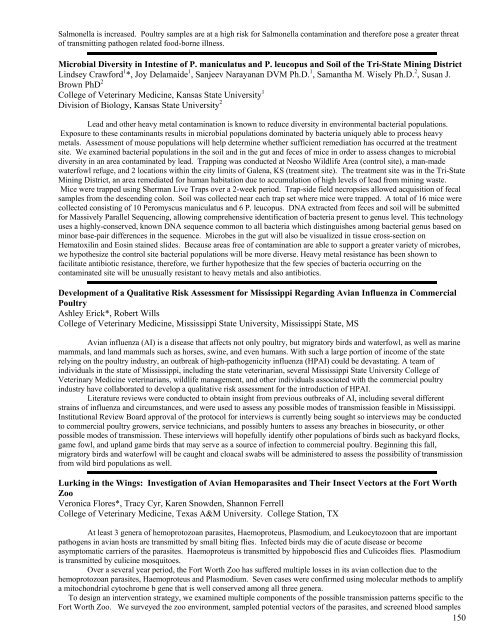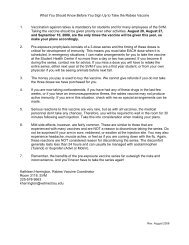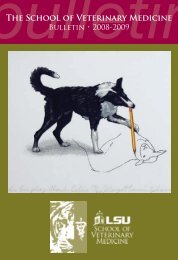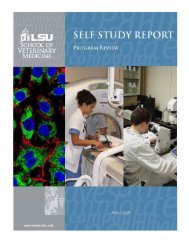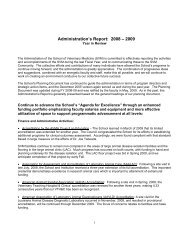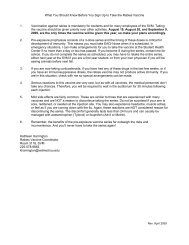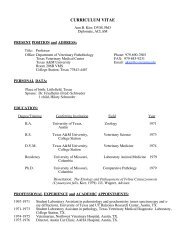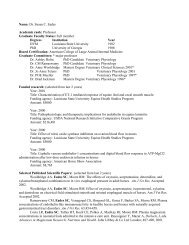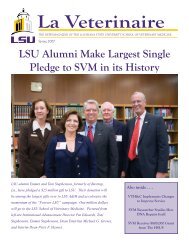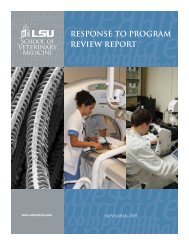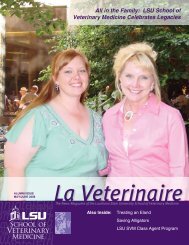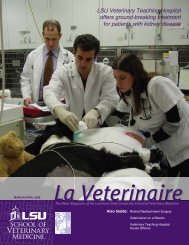2006 merck/merial - School of Veterinary Medicine - Louisiana State ...
2006 merck/merial - School of Veterinary Medicine - Louisiana State ...
2006 merck/merial - School of Veterinary Medicine - Louisiana State ...
Create successful ePaper yourself
Turn your PDF publications into a flip-book with our unique Google optimized e-Paper software.
Salmonella is increased. Poultry samples are at a high risk for Salmonella contamination and therefore pose a greater threat<strong>of</strong> transmitting pathogen related food-borne illness.Microbial Diversity in Intestine <strong>of</strong> P. maniculatus and P. leucopus and Soil <strong>of</strong> the Tri-<strong>State</strong> Mining DistrictLindsey Crawford 1 *, Joy Delamaide 1 , Sanjeev Narayanan DVM Ph.D. 1 , Samantha M. Wisely Ph.D. 2 , Susan J.Brown PhD 2College <strong>of</strong> <strong>Veterinary</strong> <strong>Medicine</strong>, Kansas <strong>State</strong> University 1Division <strong>of</strong> Biology, Kansas <strong>State</strong> University 2Lead and other heavy metal contamination is known to reduce diversity in environmental bacterial populations.Exposure to these contaminants results in microbial populations dominated by bacteria uniquely able to process heavymetals. Assessment <strong>of</strong> mouse populations will help determine whether sufficient remediation has occurred at the treatmentsite. We examined bacterial populations in the soil and in the gut and feces <strong>of</strong> mice in order to assess changes to microbialdiversity in an area contaminated by lead. Trapping was conducted at Neosho Wildlife Area (control site), a man-madewaterfowl refuge, and 2 locations within the city limits <strong>of</strong> Galena, KS (treatment site). The treatment site was in the Tri-<strong>State</strong>Mining District, an area remediated for human habitation due to accumulation <strong>of</strong> high levels <strong>of</strong> lead from mining waste.Mice were trapped using Sherman Live Traps over a 2-week period. Trap-side field necropsies allowed acquisition <strong>of</strong> fecalsamples from the descending colon. Soil was collected near each trap set where mice were trapped. A total <strong>of</strong> 16 mice werecollected consisting <strong>of</strong> 10 Peromyscus maniculatus and 6 P. leucopus. DNA extracted from feces and soil will be submittedfor Massively Parallel Sequencing, allowing comprehensive identification <strong>of</strong> bacteria present to genus level. This technologyuses a highly-conserved, known DNA sequence common to all bacteria which distinguishes among bacterial genus based onminor base-pair differences in the sequence. Microbes in the gut will also be visualized in tissue cross-section onHematoxilin and Eosin stained slides. Because areas free <strong>of</strong> contamination are able to support a greater variety <strong>of</strong> microbes,we hypothesize the control site bacterial populations will be more diverse. Heavy metal resistance has been shown t<strong>of</strong>acilitate antibiotic resistance, therefore, we further hypothesize that the few species <strong>of</strong> bacteria occurring on thecontaminated site will be unusually resistant to heavy metals and also antibiotics.Development <strong>of</strong> a Qualitative Risk Assessment for Mississippi Regarding Avian Influenza in CommercialPoultryAshley Erick*, Robert WillsCollege <strong>of</strong> <strong>Veterinary</strong> <strong>Medicine</strong>, Mississippi <strong>State</strong> University, Mississippi <strong>State</strong>, MSAvian influenza (AI) is a disease that affects not only poultry, but migratory birds and waterfowl, as well as marinemammals, and land mammals such as horses, swine, and even humans. With such a large portion <strong>of</strong> income <strong>of</strong> the staterelying on the poultry industry, an outbreak <strong>of</strong> high-pathogenicity influenza (HPAI) could be devastating. A team <strong>of</strong>individuals in the state <strong>of</strong> Mississippi, including the state veterinarian, several Mississippi <strong>State</strong> University College <strong>of</strong><strong>Veterinary</strong> <strong>Medicine</strong> veterinarians, wildlife management, and other individuals associated with the commercial poultryindustry have collaborated to develop a qualitative risk assessment for the introduction <strong>of</strong> HPAI.Literature reviews were conducted to obtain insight from previous outbreaks <strong>of</strong> AI, including several differentstrains <strong>of</strong> influenza and circumstances, and were used to assess any possible modes <strong>of</strong> transmission feasible in Mississippi.Institutional Review Board approval <strong>of</strong> the protocol for interviews is currently being sought so interviews may be conductedto commercial poultry growers, service technicians, and possibly hunters to assess any breaches in biosecurity, or otherpossible modes <strong>of</strong> transmission. These interviews will hopefully identify other populations <strong>of</strong> birds such as backyard flocks,game fowl, and upland game birds that may serve as a source <strong>of</strong> infection to commercial poultry. Beginning this fall,migratory birds and waterfowl will be caught and cloacal swabs will be administered to assess the possibility <strong>of</strong> transmissionfrom wild bird populations as well.Lurking in the Wings: Investigation <strong>of</strong> Avian Hemoparasites and Their Insect Vectors at the Fort WorthZooVeronica Flores*, Tracy Cyr, Karen Snowden, Shannon FerrellCollege <strong>of</strong> <strong>Veterinary</strong> <strong>Medicine</strong>, Texas A&M University. College Station, TXAt least 3 genera <strong>of</strong> hemoprotozoan parasites, Haemoproteus, Plasmodium, and Leukocytozoon that are importantpathogens in avian hosts are transmitted by small biting flies. Infected birds may die <strong>of</strong> acute disease or becomeasymptomatic carriers <strong>of</strong> the parasites. Haemoproteus is transmitted by hippoboscid flies and Culicoides flies. Plasmodiumis transmitted by culicine mosquitoes.Over a several year period, the Fort Worth Zoo has suffered multiple losses in its avian collection due to thehemoprotozoan parasites, Haemoproteus and Plasmodium. Seven cases were confirmed using molecular methods to amplifya mitochondrial cytochrome b gene that is well conserved among all three genera.To design an intervention strategy, we examined multiple components <strong>of</strong> the possible transmission patterns specific to theFort Worth Zoo. We surveyed the zoo environment, sampled potential vectors <strong>of</strong> the parasites, and screened blood samples150


